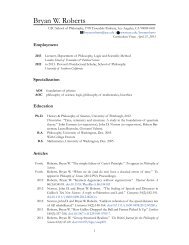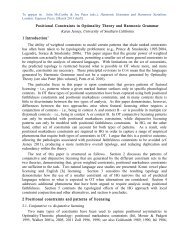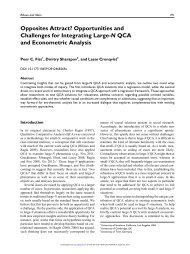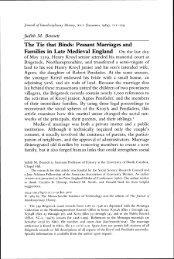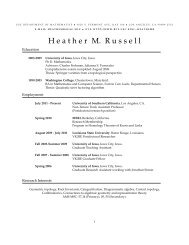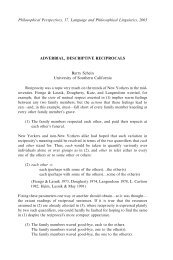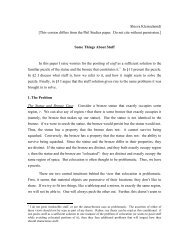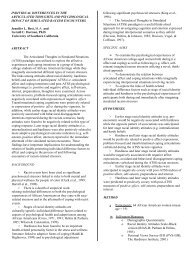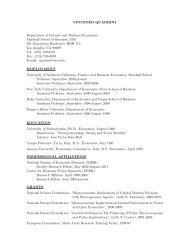The Diffusion of Ideas over Contested Terrain - Personal World Wide ...
The Diffusion of Ideas over Contested Terrain - Personal World Wide ...
The Diffusion of Ideas over Contested Terrain - Personal World Wide ...
You also want an ePaper? Increase the reach of your titles
YUMPU automatically turns print PDFs into web optimized ePapers that Google loves.
#2144-ASQ V49 N4-December 2005—file: 49401-fiss<br />
g<strong>over</strong>nance, while the opposite would be true <strong>of</strong> older executives.<br />
This suggests that the effect <strong>of</strong> educational background<br />
will diminish with increasing age:<br />
Hypothesis 2c (H2c): <strong>The</strong> relationship between educational background<br />
(in economics or law) and a shareholder value orientation<br />
espousal is significantly weaker for firms with older chief executive<br />
<strong>of</strong>ficers.<br />
Espousal and Implementation<br />
In following the traditional diffusion model, most previous<br />
studies have employed a binary dependent variable for adoption/non-adoption,<br />
but this approach “does not differentiate<br />
between ‘superficial’ and ‘deep’ adoption—that is, it reveals<br />
nothing about the extent to which the innovation has been<br />
employed” (Downs, 1976: 39). More recently, a number <strong>of</strong><br />
studies have examined whether adoption is in fact decoupled<br />
from implementation. For example, Westphal and Zajac<br />
(1994, 2001) found that the symbolic adoption <strong>of</strong> long-term<br />
incentive plans and stock repurchase programs is frequently<br />
decoupled from their implementation, particularly in firms<br />
with powerful chief executive <strong>of</strong>ficers.<br />
<strong>The</strong> concept <strong>of</strong> decoupling suggests that organizations may<br />
engage in actions that seemingly show compliance but actually<br />
conceal nonconformity (Oliver, 1991; Elsbach and Sutton,<br />
1992). Consistent with Westphal and Zajac (1994, 2001), we<br />
are agnostic as to whether such actions are motivated by<br />
either well-intentioned senior managers, who believe the<br />
organization is better served by using symbols to placate<br />
those influential external constituents that they believe lack<br />
the perspective to assess the firm’s long-run best course <strong>of</strong><br />
action, or narrowly self-interested senior managers, simply<br />
focused on their own narrow career interests. Yet a closer<br />
consideration <strong>of</strong> the ownership groups and executive characteristics<br />
described above suggests that they may have different<br />
impacts on the likelihood <strong>of</strong> a firm’s decoupling <strong>of</strong> a<br />
shareholder value orientation espousal from the implementation<br />
<strong>of</strong> commensurate g<strong>over</strong>nance practices.<br />
Ownership groups may differ in their incentives and ability to<br />
monitor whether management follows through on its stated<br />
intentions. In the German context, corporate owners such as<br />
banks and other firms should be particularly effective at monitoring<br />
because <strong>of</strong> their long-term relationship with the firm,<br />
their frequent representation on the supervisory board, and<br />
sufficient resources and knowledge <strong>of</strong> the managerial<br />
process to ensure follow-through. <strong>The</strong>refore, if corporate<br />
owners themselves espouse a shareholder value orientation,<br />
we would expect them to have both the incentives and the<br />
resources to ensure subsequent implementation <strong>of</strong> the commensurate<br />
g<strong>over</strong>nance practices. In contrast, non-corporate<br />
owners such as g<strong>over</strong>nments and family owners may have<br />
fewer incentives or organizational resources to assure structural<br />
changes. While pro-business g<strong>over</strong>nments may be more<br />
likely to support a move toward a shareholder value orientation,<br />
they still have to attend to the interests <strong>of</strong> several corporate<br />
stakeholders, making them less likely to invest the<br />
resources required to ensure follow-through. Later-generation<br />
512/ASQ, December 2004



